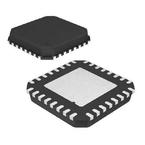herunterladen

AN-746
APPLICATION NOTE
One Technology Way • P.O. Box 9106 • Norwood, MA 02062-9106 • Tel: 781/329-4700 • Fax: 781/461-3113 • www.analog.com
INTRODUCTION
The ADN2812 continuous-rate clock and data recovery
device (CDR) can support all NRZ and NRZI random
data patterns between 12.3 Mbps and 2.7 Gbps, and is
protocol agnostic. The default operating mode of the
ADN2812, lock to data mode, is for the CDR to lock on
to any incoming data rate automatically, without the
need of programming or external reference clocks.
This requires that the incoming data is random NRZ or
NRZI data. In lock to data mode, it is required that the
bit pattern have transitions at the desired frequency
(e.g., 0101), so that the frequency-locked loop can detect
the correct frequency of the bit pattern.
If the data pattern does not meet this requirement, then it
is possible to program the ADN2812 to lock to an external
reference clock so that nonrandom bit patterns can be
accommodated at the desired frequency. An example of
a situation where the ADN2812 needs to be placed in lock
to REFCLK mode is when an FDDI port is attempting to
connect to another FDDI port.
FDDI CONNECTION PROTOCOL
Within every FDDI station there are SMT (station man-
agement) entities called PCM (physical connection
management). The number of PCM entities within a
station is exactly equal to the number of ports that the
station has. This is because each PCM is responsible for
one port.
The PCM entities are the part of SMT that controls the
ports. In order to make a connection, two ports must be
physically connected to each other by means of a fiber-
optic or copper cable. When this happens, the PCMs
that are responsible for those ports can recognize each
other’s existence and begin communicating. They do
this by sending line states out of the port and onto the
fiber. The PCM at the other end of the connection will
recognize the line state and respond accordingly.
When the PCM sees another PCM on the other end of
the connection, they will synchronize and communicate
with each other. During this communication, a couple of
important things happen:
1. The PCMs figure out the types of each port, and deter-
mine if they are compatible.
2. The PCMs perform an LCT (link confidence test).
Supporting FDDI with the ADN2812
by Kevin Buckley
The LCT determines if the quality of the link is good
enough to establish a connection on. If it is not, the PCMs
will not make a connection. If everything goes well dur-
ing this signaling, the PCMs will establish a connection
and place the ports on the token path that goes through
that station. At this point, data (in the form of frames)
can be sent through these ports and the ports become
part of the network.
PCM entities have a number of internal states that they
can be in. While in any state, the PCM has the port send
out a certain line state. This line state will be received by
the PCM on the other side of the connection. The other
PCM entity (at the other end of the connection) will be
able to tell which state the original PCM is in. PCMs use
this information to signal data across the connection.
The connection attempt begins with the PCM state:
break. The break state is the entry point in the start
of a PCM connection. In the break state, a continuous
stream of Q symbols (QLS; 00000) is transmitted to
force the other end of the connection to break any exist-
ing connection and restart the connection initialization
sequence. The break state is entered upon the start of a
connection attempt, or if there was a problem with the
previous connection attempt.
Once the PCM has begun to receive the correct symbols
from the other side, the link will transition to the connect
state. The connect state is used to synchronize the ends
of the connection for the signaling sequence.
In the connect state, the PCM transmits a continuous
stream of H symbols (HLS; 00100). The PCM stays in
this state until it receives HLS from the other end of
the connection. The reception of HLS indicates that the
other PCM is also in the connect state. If the PCM is not
attached to anything at all, then it will be receiving QLS
and will remain here until it is connected to another PCM
that sources HLS.
Once the connect state is successful, the link transitions
to the next state. While in the next state, a continuous
stream of I symbols is transmitted (ILS; 11111). The next
state is used to separate the signaling performed in the
signal state and it is where the LCT (link confidence test)
is performed.
REV. 0






